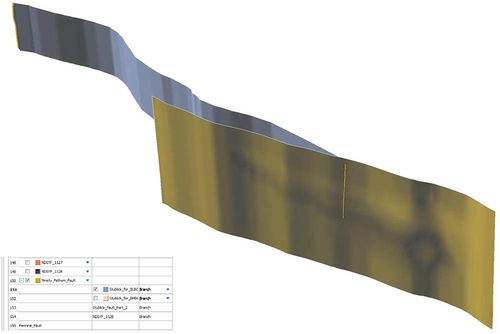OR/14/028 Software used and model workflow: Difference between revisions
Jump to navigation
Jump to search
Created page with "__notoc__ {{OR/14/028}} ==Software used== * GOCAD® version 2.5.2 and GOCAD® v2009 * ArcGIS 9.3 * MS Excel ==Model workflow== The following workflow was used to generate the..." |
No edit summary |
||
| (4 intermediate revisions by the same user not shown) | |||
| Line 11: | Line 11: | ||
# Compiled all raw data into a GIS: W:\Teams\UKGF\RegionalLithoframe\Data\Weald\weald.mxd | # Compiled all raw data into a GIS: W:\Teams\UKGF\RegionalLithoframe\Data\Weald\weald.mxd | ||
# Imported all fault traces, outcrop data and structural contours for each horizon into GOCAD®. | # Imported all fault traces, outcrop data and structural contours for each horizon into GOCAD®. | ||
# Additional data added included the CEH DTM data points (See Model | # Additional data added included the CEH DTM data points (See [[OR/14/028 Model datasets |Model datasets]]) | ||
# A raw surface (uncut by faults at this stage) for each horizon was modelled using a combination of the structural contours and outcrop which had elevation values applied from the DTM surface data. | # A raw surface (uncut by faults at this stage) for each horizon was modelled using a combination of the structural contours and outcrop which had elevation values applied from the DTM surface data. | ||
# Every fault trace was draped onto its corresponding surface using the ‘Transfer Property by Vertical Projection’ tool and then following the methodology established in [[OR/14/028 Modelled faults #Fault sticks |Fault sticks]] and [[OR/14/028 Modelled faults #Fault center lines |Fault center lines]], the fault plane was constructed. | |||
# Every fault trace was draped onto its corresponding surface using the ‘Transfer Property by Vertical Projection’ tool and then following the methodology established in | |||
# Once all of the faults had been constructed, branch contacts were established between the faults using the Structural Modelling workflow. | # Once all of the faults had been constructed, branch contacts were established between the faults using the Structural Modelling workflow. | ||
# The faults were then used to cut the raw surface horizons using the ‘Horizon-Fault Contact Modelling’ in the Structural Modelling workflow. | # The faults were then used to cut the raw surface horizons using the ‘Horizon-Fault Contact Modelling’ in the Structural Modelling workflow. | ||
# Fault contacts and surface horizons were either edited using the Structural Modelling workflow parameters or manually using the tools available in GOCAD® | # Fault contacts and surface horizons were either edited using the Structural Modelling workflow parameters or manually using the tools available in GOCAD® | ||
| Line 22: | Line 20: | ||
# Any surface intersections were then removed using the ‘Remove crossovers’ dialogue. | # Any surface intersections were then removed using the ‘Remove crossovers’ dialogue. | ||
[[Image: | [[Image:OR14028_fig8.jpg|thumb|center| 500px|'''Figure 8''' Example fault contact from the Northumberland-Solway Model between the Ninety Fathom fault (Main) and the Stublick fault (branch) from Terrington ''et al ''(2013)<ref name="Terrington">TERRINGTON, R L, and THORPE, S. 2013. Metadata report for the Northumberland and Solway Basin 1:250 000 geological model. ''British Geological Survey'', OR/13/049 (British Geological Survey). </ref>.]] | ||
==Reference== | |||
[[category: OR/14/028 Metadata report for the Weald Basin 1:250 000 resolution geological model | 07]] | [[category: OR/14/028 Metadata report for the Weald Basin 1:250 000 resolution geological model | 07]] | ||
Latest revision as of 10:53, 10 August 2015
| Hulbert A G, Terrington R L. 2015. Metadata report for the Weald Basin 1:250 000 resolution geological model. British Geological Survey Internal Report, OR/14/028. |
Software used
- GOCAD® version 2.5.2 and GOCAD® v2009
- ArcGIS 9.3
- MS Excel
Model workflow
The following workflow was used to generate the Weald Basin Model:
- Compiled all raw data into a GIS: W:\Teams\UKGF\RegionalLithoframe\Data\Weald\weald.mxd
- Imported all fault traces, outcrop data and structural contours for each horizon into GOCAD®.
- Additional data added included the CEH DTM data points (See Model datasets)
- A raw surface (uncut by faults at this stage) for each horizon was modelled using a combination of the structural contours and outcrop which had elevation values applied from the DTM surface data.
- Every fault trace was draped onto its corresponding surface using the ‘Transfer Property by Vertical Projection’ tool and then following the methodology established in Fault sticks and Fault center lines, the fault plane was constructed.
- Once all of the faults had been constructed, branch contacts were established between the faults using the Structural Modelling workflow.
- The faults were then used to cut the raw surface horizons using the ‘Horizon-Fault Contact Modelling’ in the Structural Modelling workflow.
- Fault contacts and surface horizons were either edited using the Structural Modelling workflow parameters or manually using the tools available in GOCAD®
- Surfaces were then fitted to crop using the ‘Border on curve’ surface constraint.
- Any surface intersections were then removed using the ‘Remove crossovers’ dialogue.

Reference
- ↑ TERRINGTON, R L, and THORPE, S. 2013. Metadata report for the Northumberland and Solway Basin 1:250 000 geological model. British Geological Survey, OR/13/049 (British Geological Survey).